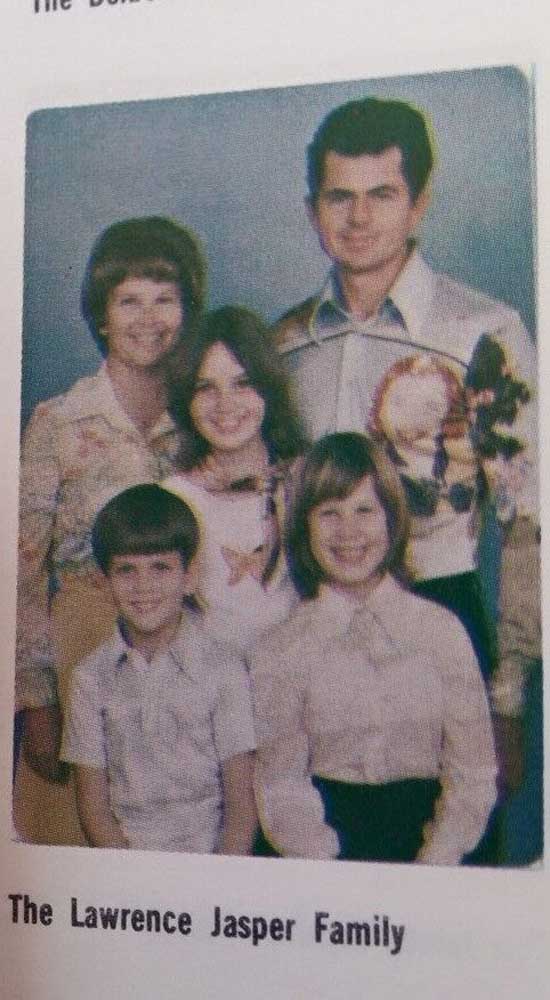A defense of disco
Published 2:15 am Thursday, August 13, 2020

- This church yearbook photo was taken in 1976, when disco music was becoming big, like the collars of polyester shirts worn here by the entire Jasper family. Submitted photo
If you’re over the age of 45, you probably remember seeing a “Death before disco” T-shirt at some point in your life, or its to-the-point cousin, “Disco sucks.” Imagine hating a music genre (with a beat you can dance to!) so much you felt the need to broadcast that to the world.
Personally, I can’t stand the stale twang and faux populism of commercial country. I grumble to myself every time I go into the south Albertson’s in Bend lately because commercial country has been the store’s go-to since the pandemic began. Fortunately, my mask hides my disgust, I hope. (I am especially triggered by the song “Somebody Slap Me,” with a chorus in which singer John Anderson repeats, ad nauseam, “Somebody slap me.” Miraculously, it reached No. 22 on the charts in 1997, according to “Hot Country Songs.”)
But I’m not willing (yet) to slap a “Country sucks” slogan on a T-shirt to alert the world to my position on the execrable genre. Yet there was a time, way back when the world was a much simpler place, that “Disco sucks” and “Death before disco” shirts were a thing, and I guarantee you there are still dudes in their 40s and 50s who would mutter in their masks if the subject of disco music came up.
“It’s all right. It’s OK. You may look the other way.”
Those lyrics come from “Stayin’ Alive,” the mega-hit The Bee Gees wrote for “Saturday Night Fever,” the discomania movie that made actor John Travolta famous as something other than one of Mr. Kotter’s Sweathogs.
It’s also the first song on my Spotify playlist “Guilty pleasures.” The list could also be titled “Songs I’d be embarrassed for friends to see on a playlist I made.” Let’s just say that the list has some disco, and no fewer than three songs by hometown heroes — that is my hometown of Miami — KC and the Sunshine Band.
Here’s a little-known fact about “Stayin’ Alive”: The song has been used to train people in CPR because its rhythm is 103 beats per minute — the number of recommended chest compressions for saving a life being between 100 and 120. While not the only disco song on New York-Presbyterian Hospital’s “Songs to do CPR to” playlist, it’s the only one named “Stayin’ Alive.”
Crazy, right? Hey, speaking of crazy training, can you say that any songs done by your precious Ozzy were used in CPR training? Why, yes, you can, actually: Ozzy covered “Stayin’ Alive” — a fact I love no less for just having learned it.
Like Ozzy, I have an appreciation of late-1970s music. Unlike Ozzy, I was way too young to enjoy any of the decade’s decadent amenities, such as Studio 54, which was the place to be for certain headline-making, cocaine-snorting celebrities. I was just a little kid, a loner who knew nothing about music beyond the pop embraced by my two older sisters and the sounds emanating from the radio. In those days, I still had an attention span and could sit on the floor and play with Legos until my legs went numb. My mom would occasionally pop by to insist I eat some food and drink water.
My soundtrack was Y100, an unapologetically top-40 station. And the top-40 in 1978 and ’79 was unapologetically filled not with new wave or punk rock but with disco: The upbeat rhythms of “Funky Town,” “Boogie Shoes” and “Tragedy” fueled my nerdy Lego-sculpting needs before I was old enough to worry about what was or wasn’t “cool.”
Other than my guilty pleasures playlist, disco is not exactly in heavy rotation, my defense of it notwithstanding. But its influences reverberate: My kids still think it’s funny that I’m a sucker for the falsetto of Brian Wilson, Frankie Valli and Chris Isaak. If I had to guess, that proclivity for soaring high notes goes back to none other than Barry Gibb.
Troy Brownfield, in an excellent piece from last year titled “The Week of Peak Disco,” tells that the week of July 21, 1979, was disco’s peak (saturdayeveningpost.com/2019/07/the-week-of-peak-disco). No fewer than seven of the top 10 songs were of the disco variety, and the hitmakers included ELO — not technically a disco band, but like Blondie with “Heart of Glass,” more than capable of dabbling in the form.
Donna Summer had the No. 1 and 3 positions with “Bad Girls” and “Hot Stuff,” respectively.
A month later, the new wave classic “My Sharona” lodged itself at the No. 1 chart position for six weeks.
“Disco would continue to dot the charts for a while, but the cultural backlash caused many artists to simply relabel themselves as ‘dance,’” Brownfield wrote.
That jibes with memory. I started junior high in 1980 when disco was already well into its death throes, and I dimly recall being impressed by the “Death before disco” backlash evidenced by the T-shirts worn by older dudes on the school bus.
In retrospect, of course, such shirts were not exactly a bold choice.
Quietly fermenting in my brain for the past 40 years is a belief that a strongly held anti-disco sentiment is just the calling card of mediocre guys who aspired, desperately, to appear cool and, let’s be honest here, more heteronormative. It’s the toxic masculinity of music opinions, the equivalent of broadcasting your cool by taking up two parking spaces and wearing your sunglasses on the back of your head indoors.
I get it now. You’re insecure and you lack rhythm.
As for those of us who refuse to despise disco as prescribed by the groupthinkers, as the great Mr. Gibb sang, “We got nothing to be guilty of … and we got nothing to be sorry for.”






